Ask a question from expert
FNSACC502 Prepare Tax Documentation For Individuals
43 Pages9628 Words56 Views
Prepare Legally Compliant Tax Returns (FNSACC502)
Added on 2020-04-21
FNSACC502 Prepare Tax Documentation For Individuals
Prepare Legally Compliant Tax Returns (FNSACC502)
Added on 2020-04-21
BookmarkShareRelated Documents
Prepare Legally Compliant Tax Returns for Individuals
This course is based on the nationally recognised unit of competency:
● FNSACC502 Prepare Legally Compliant Tax Returns for Individuals
It covers the skills and knowledge required to prepare, document and
manage budgets and forecasts, and encompasses forecasting estimates
and monitoring budgeted outcomes.
ASSESSMENT WORKBOOK
Participant Name:
Learner ID/Username:
This course is based on the nationally recognised unit of competency:
● FNSACC502 Prepare Legally Compliant Tax Returns for Individuals
It covers the skills and knowledge required to prepare, document and
manage budgets and forecasts, and encompasses forecasting estimates
and monitoring budgeted outcomes.
ASSESSMENT WORKBOOK
Participant Name:
Learner ID/Username:

Assessment Workbook Y1: Prepare Legally Compliant Tax Returns for Individuals
Assessment Workbook Y1
Prepare Legally Compliant Tax Returns for Individuals
V1.0
Produced 1 February 2016
Copyright © 2016
All rights reserved. No part of this publication maybe reproduced or distributed in any form or by
any means, or stored in a database or retrieval system other than pursuant to the terms of the
Copyright Act 1968 (Commonwealth).
Date Summary of Modifications
Made
Version
1/02/16 Version 1 produced following
assessment validation
V1.0
Page 1
Assessment Workbook Y1
Prepare Legally Compliant Tax Returns for Individuals
V1.0
Produced 1 February 2016
Copyright © 2016
All rights reserved. No part of this publication maybe reproduced or distributed in any form or by
any means, or stored in a database or retrieval system other than pursuant to the terms of the
Copyright Act 1968 (Commonwealth).
Date Summary of Modifications
Made
Version
1/02/16 Version 1 produced following
assessment validation
V1.0
Page 1
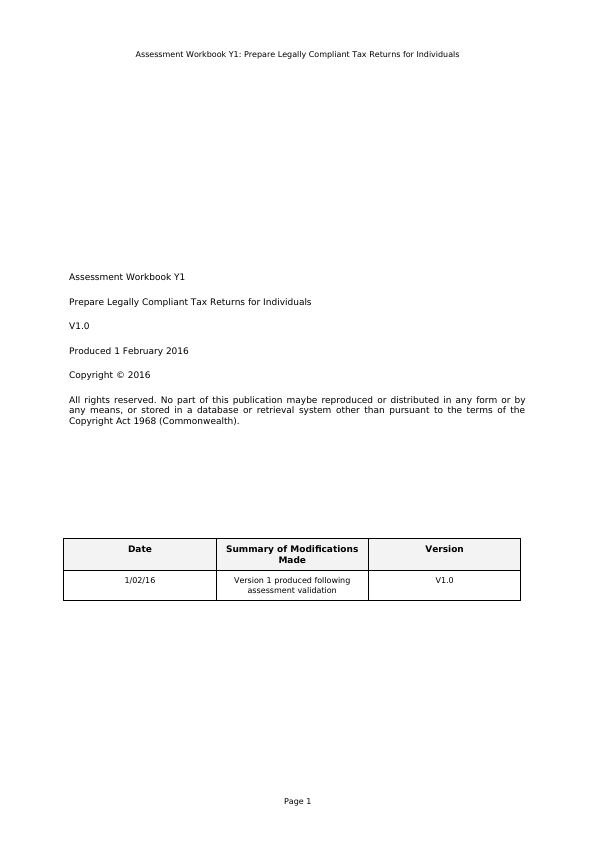
Assessment Workbook Y1: Prepare Legally Compliant Tax Returns for Individuals
Getting Started
Instructions
There is one (1) workbook for this unit and it contains one (1) assessment
made up of:
● Written Questions – A set of generic questions testing the student’s
general knowledge and understanding of the general theory behind
the unit.
● Exercises - A set of exercises to test the student’s knowledge,
analytical skills in problem solving and performing numerical
calculations.
● Case Study – A hypothetical exercise to test the student’s knowledge,
analytical skills in problem solving and performing numerical
calculations.
The following questions are divided into the following categories.
The first part of the assessment covers generic underpinning knowledge of
tax law and concepts. These questions are all in a short answer format. The
longer questions requiring creative thought processes are covered in the
second part of the assessment and the case study and involve the
calculation of tax transactions. You must answer all questions using your
own words. However you may reference your learner guide, the PMBOK
guide and other online or hard copy resources to complete this
assessment.
The second part of the assessment covers exercises relating to the
calculation and processing of taxation information. Ideally you should be
able to answer these questions based on the processes that are currently
in place in your workplace. If this is not the case, then answer the
questions based on processes that should be implemented in your
workplace.
The final part of the assessment is based on a case study involving the
completion of a tax return for an individual.
Page 2
Getting Started
Instructions
There is one (1) workbook for this unit and it contains one (1) assessment
made up of:
● Written Questions – A set of generic questions testing the student’s
general knowledge and understanding of the general theory behind
the unit.
● Exercises - A set of exercises to test the student’s knowledge,
analytical skills in problem solving and performing numerical
calculations.
● Case Study – A hypothetical exercise to test the student’s knowledge,
analytical skills in problem solving and performing numerical
calculations.
The following questions are divided into the following categories.
The first part of the assessment covers generic underpinning knowledge of
tax law and concepts. These questions are all in a short answer format. The
longer questions requiring creative thought processes are covered in the
second part of the assessment and the case study and involve the
calculation of tax transactions. You must answer all questions using your
own words. However you may reference your learner guide, the PMBOK
guide and other online or hard copy resources to complete this
assessment.
The second part of the assessment covers exercises relating to the
calculation and processing of taxation information. Ideally you should be
able to answer these questions based on the processes that are currently
in place in your workplace. If this is not the case, then answer the
questions based on processes that should be implemented in your
workplace.
The final part of the assessment is based on a case study involving the
completion of a tax return for an individual.
Page 2
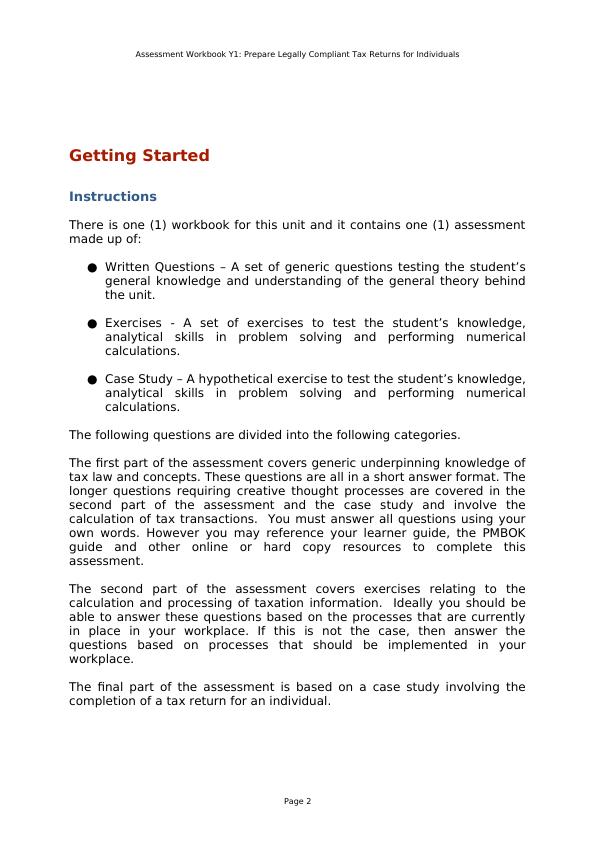
Assessment Workbook Y1: Prepare Legally Compliant Tax Returns for Individuals
Requirements for satisfactory completion
For a ‘satisfactory’ result for each component of this workbook, all tasks
must be addressed to a ‘satisfactory’ standard. It is important you;
1. Provide responses using complete sentences, making direct
reference to the question.
2. Specifically address all parts of the question providing examples
where appropriate.
Competency Based Assessment
Competency based assessment focuses on whether you are able to
perform the task to the standard expected in the workplace. It relies on
you providing evidence that supports your claim of competence. This
evidence is in the form of your completion of the assessments set for each
unit.
Once you have submitted your completed assessments, your instructor will
assess your submission to determine your competence. To be deemed
competent in each course, you are required to achieve a satisfactory result
for all of the assessment components that make up that unit. Where a ‘not
yet satisfactory’ judgement is made, you will be given guidance on steps to
take to improve your performance and provided the opportunity to re-
submit evidence to demonstrate competence. Once a ‘satisfactory’
judgement has been made on all components for a unit, you will be
deemed ‘competent’ in that unit.
Submission
Only submit your workbook once all activities inside are complete. Should
you have any questions regarding your assessments, or not understand
what is required for you to complete your assessment, please feel free to
ask your instructor.
Keep your answers succinct and make sure you are answering the
question. Re-read the question after you have drafted up your response
just to be sure you have covered all that is needed.
Your final assessment result will either be ‘Competent’ or ‘Not Yet
Competent’.
When submitting your assessments please ensure that
Page 3
Requirements for satisfactory completion
For a ‘satisfactory’ result for each component of this workbook, all tasks
must be addressed to a ‘satisfactory’ standard. It is important you;
1. Provide responses using complete sentences, making direct
reference to the question.
2. Specifically address all parts of the question providing examples
where appropriate.
Competency Based Assessment
Competency based assessment focuses on whether you are able to
perform the task to the standard expected in the workplace. It relies on
you providing evidence that supports your claim of competence. This
evidence is in the form of your completion of the assessments set for each
unit.
Once you have submitted your completed assessments, your instructor will
assess your submission to determine your competence. To be deemed
competent in each course, you are required to achieve a satisfactory result
for all of the assessment components that make up that unit. Where a ‘not
yet satisfactory’ judgement is made, you will be given guidance on steps to
take to improve your performance and provided the opportunity to re-
submit evidence to demonstrate competence. Once a ‘satisfactory’
judgement has been made on all components for a unit, you will be
deemed ‘competent’ in that unit.
Submission
Only submit your workbook once all activities inside are complete. Should
you have any questions regarding your assessments, or not understand
what is required for you to complete your assessment, please feel free to
ask your instructor.
Keep your answers succinct and make sure you are answering the
question. Re-read the question after you have drafted up your response
just to be sure you have covered all that is needed.
Your final assessment result will either be ‘Competent’ or ‘Not Yet
Competent’.
When submitting your assessments please ensure that
Page 3
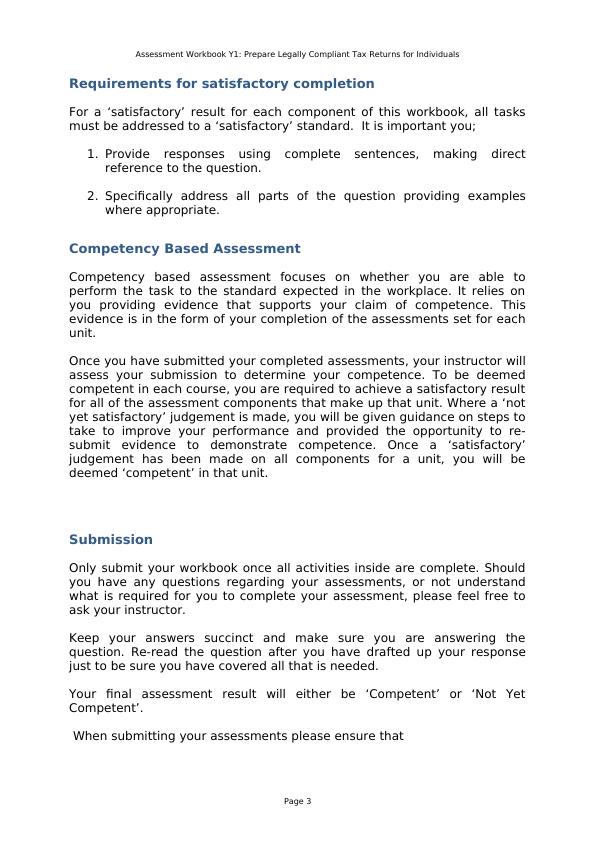
Assessment Workbook Y1: Prepare Legally Compliant Tax Returns for Individuals
1. All assessment tasks within the workbook have been completed
2. You have proof read your assessment
Candidate Declaration
Submission of this workbook means you agree to abide by the terms of the
candidate declaration below.
By submitting this work, I declare that:
● I have been advised of the assessment requirements, have been
made aware of my rights and responsibilities as an assessment
candidate, and choose to be assessed at this time.
● I am aware that there is a limit to the number of submissions that I
can make for each assessment and I am submitting all documents
required to complete this Assessment Workbook.
● I have organised and named the files I am submitting according to
the instructions provided and I am aware that my assessor will not
assess work that cannot be clearly identified and may request the
work be resubmitted according to the correct process.
● This work is my own and contains no material written by another
person except where due reference is made. I am aware that a false
declaration may lead to the withdrawal of a qualification or
statement of attainment.
● I am aware that there is a policy of checking the validity of
qualifications that I submit as evidence as well as the
qualifications/evidence of parties who verify my performance or
observable skills. I give my consent to contact these parties for
verification purposes.
Page 4
1. All assessment tasks within the workbook have been completed
2. You have proof read your assessment
Candidate Declaration
Submission of this workbook means you agree to abide by the terms of the
candidate declaration below.
By submitting this work, I declare that:
● I have been advised of the assessment requirements, have been
made aware of my rights and responsibilities as an assessment
candidate, and choose to be assessed at this time.
● I am aware that there is a limit to the number of submissions that I
can make for each assessment and I am submitting all documents
required to complete this Assessment Workbook.
● I have organised and named the files I am submitting according to
the instructions provided and I am aware that my assessor will not
assess work that cannot be clearly identified and may request the
work be resubmitted according to the correct process.
● This work is my own and contains no material written by another
person except where due reference is made. I am aware that a false
declaration may lead to the withdrawal of a qualification or
statement of attainment.
● I am aware that there is a policy of checking the validity of
qualifications that I submit as evidence as well as the
qualifications/evidence of parties who verify my performance or
observable skills. I give my consent to contact these parties for
verification purposes.
Page 4
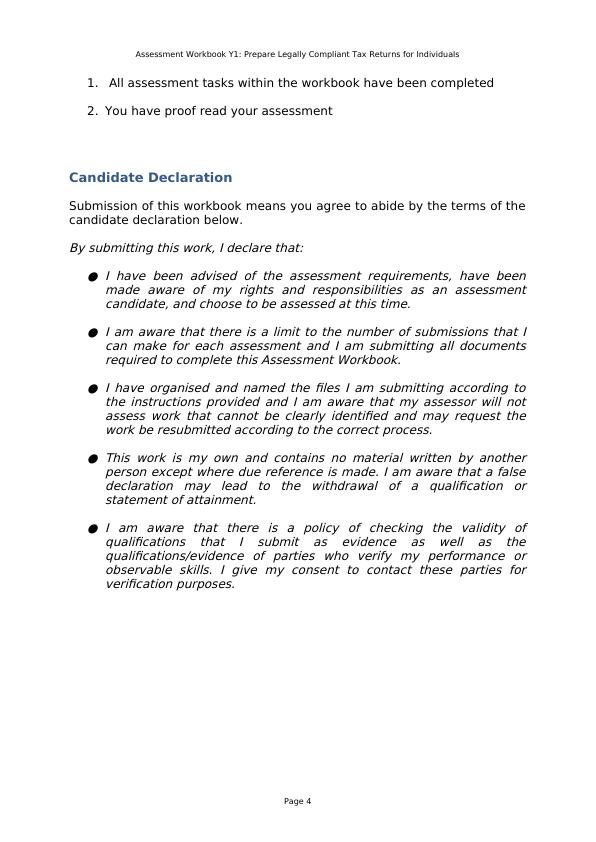
Assessment Workbook Y1: Prepare Legally Compliant Tax Returns for Individuals
Written Questions
Instructions
The following questions are divided into two categories.
The first part of the assessment covers generic underpinning knowledge of
tax law and concepts. These questions are all in a short answer format. The
longer questions requiring creative thought processes are covered in the
second part of the assessment and the case study and involve the
calculation of tax transactions. You must answer all questions using your
own words. However you may reference your learner guide, the PMBOK
guide and other online or hard copy resources to complete this
assessment.
The second part of the assessment covers exercises relating to the
calculation and processing of taxation information. Ideally you should be
able to answer these questions based on the processes that are currently
in place in your workplace. If this is not the case, then answer the
questions based on processes that should be implemented in your
workplace.
The final part of the assessment is based on a case study involving the
completion of a tax return for an individual.
Generic Questions
Y1Q1: Name the principal legislation that governs taxation law in
Australia (Two (2) required).
Under section 51(ii) of the Australian Constitution it is stated that for the
Commonwealth of Australia, the Commonwealth Parliament have the
authority and power to develop legislations for order and peace. Thus the
primary legislations which governs taxation laws in Australia constitute:
Income Tax Assessment Act 1936 or ITAA 1936
Income Tax Assessment Act 1997 or ITAA 1997
Y1Q2: Income tax is imposed upon an individual taxpayer’s taxable
income for the current year. The Australian taxation system is a
Page 5
Written Questions
Instructions
The following questions are divided into two categories.
The first part of the assessment covers generic underpinning knowledge of
tax law and concepts. These questions are all in a short answer format. The
longer questions requiring creative thought processes are covered in the
second part of the assessment and the case study and involve the
calculation of tax transactions. You must answer all questions using your
own words. However you may reference your learner guide, the PMBOK
guide and other online or hard copy resources to complete this
assessment.
The second part of the assessment covers exercises relating to the
calculation and processing of taxation information. Ideally you should be
able to answer these questions based on the processes that are currently
in place in your workplace. If this is not the case, then answer the
questions based on processes that should be implemented in your
workplace.
The final part of the assessment is based on a case study involving the
completion of a tax return for an individual.
Generic Questions
Y1Q1: Name the principal legislation that governs taxation law in
Australia (Two (2) required).
Under section 51(ii) of the Australian Constitution it is stated that for the
Commonwealth of Australia, the Commonwealth Parliament have the
authority and power to develop legislations for order and peace. Thus the
primary legislations which governs taxation laws in Australia constitute:
Income Tax Assessment Act 1936 or ITAA 1936
Income Tax Assessment Act 1997 or ITAA 1997
Y1Q2: Income tax is imposed upon an individual taxpayer’s taxable
income for the current year. The Australian taxation system is a
Page 5
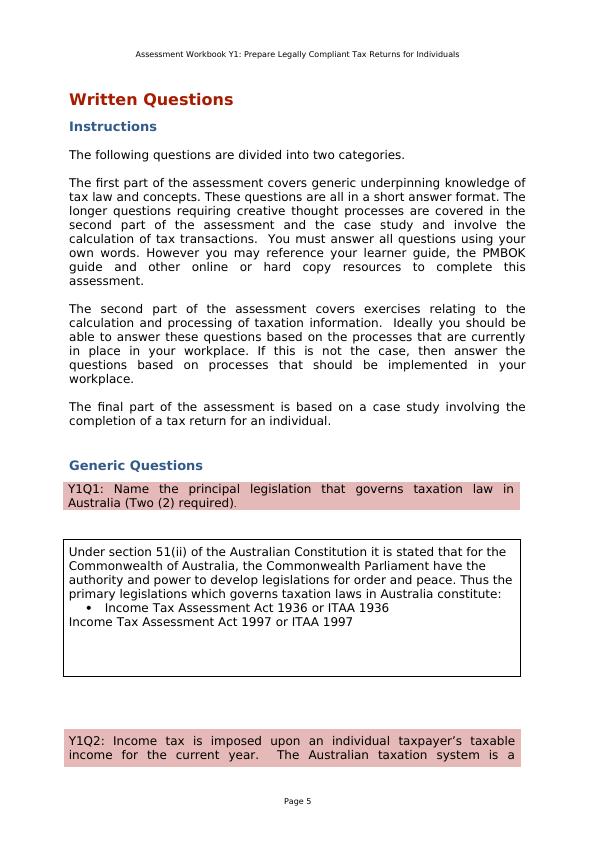
Assessment Workbook Y1: Prepare Legally Compliant Tax Returns for Individuals
progressive tax system. What is meant by the terms “progressive tax
system” and “PAYG tax”?
The obligatory contribution towards the state revenue by any individual,
businesses or other entities is known as Tax. On the basis of an
individual’s or company’s or entity’s taxable income for the present
financial year income tax is levied upon them. Moreover in Australia, the
system of progressive taxation system is followed which implies that with
an increase in an individual’s taxable income, taxes that are levied on
them also increases gradually. Thus the more an individual will earn, the
more he had to pay the tax. Hence this concept is known as progressive
tax system.
In case of any employee who is a taxpayer in Australia an amount is
withheld from the gross salaries or wages of the individual as
installments of that person’s total tax liability. This withholding is known
as the system of Pay As You Go Tax or PAYG Tax.
Y1Q3: Based on the individual income tax rates for Australian residents
able to claim the tax free threshold for 2013-2014 (exclusive of the
medicare levy of 1.5%), calculate the amount of income tax to be paid for
the following amounts of taxable income:
Y1Q3A $95,000
Y1Q3B $36,000
Y1Q3C $250,000
Y1Q3D $19,500
Y1Q3A
Tax Payable= 17547+ (95000-80000) X37%= $23097.
Y1Q3B
Tax Payable= (36000-18200)X 19%= $3382
Y1Q3C
Tax payable= 54547+ (250000-180000) X 45%= $86047.
Page 6
progressive tax system. What is meant by the terms “progressive tax
system” and “PAYG tax”?
The obligatory contribution towards the state revenue by any individual,
businesses or other entities is known as Tax. On the basis of an
individual’s or company’s or entity’s taxable income for the present
financial year income tax is levied upon them. Moreover in Australia, the
system of progressive taxation system is followed which implies that with
an increase in an individual’s taxable income, taxes that are levied on
them also increases gradually. Thus the more an individual will earn, the
more he had to pay the tax. Hence this concept is known as progressive
tax system.
In case of any employee who is a taxpayer in Australia an amount is
withheld from the gross salaries or wages of the individual as
installments of that person’s total tax liability. This withholding is known
as the system of Pay As You Go Tax or PAYG Tax.
Y1Q3: Based on the individual income tax rates for Australian residents
able to claim the tax free threshold for 2013-2014 (exclusive of the
medicare levy of 1.5%), calculate the amount of income tax to be paid for
the following amounts of taxable income:
Y1Q3A $95,000
Y1Q3B $36,000
Y1Q3C $250,000
Y1Q3D $19,500
Y1Q3A
Tax Payable= 17547+ (95000-80000) X37%= $23097.
Y1Q3B
Tax Payable= (36000-18200)X 19%= $3382
Y1Q3C
Tax payable= 54547+ (250000-180000) X 45%= $86047.
Page 6
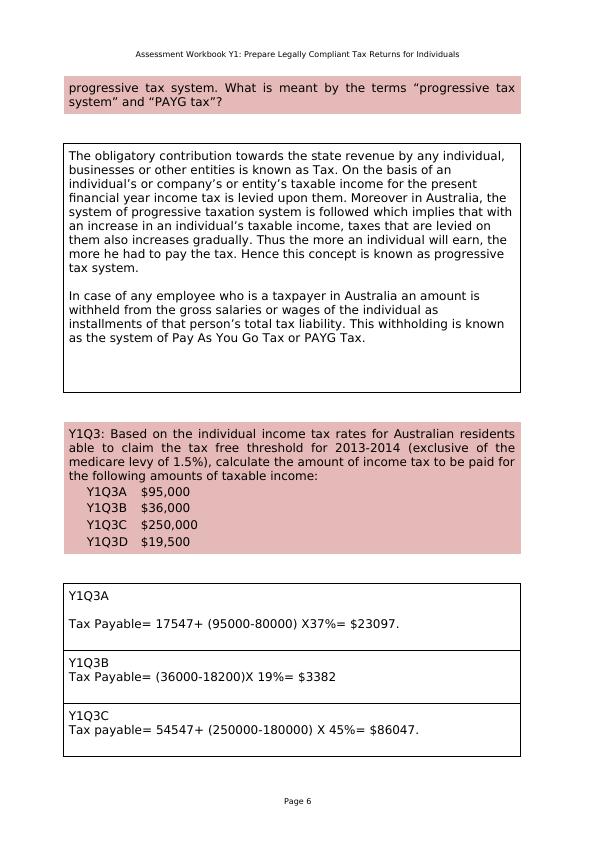
Assessment Workbook Y1: Prepare Legally Compliant Tax Returns for Individuals
Y1Q3D
Tax Payable= (19500-18200)X19%= $247.
Y1Q4: Richard has a taxable income of $125,000 for the year ended 2011
2012. His wife Emily has a taxable income of $35,000. They have two
(2) dependent children and do not have private hospital cover. Will
Richard and Emily have to pay a medicare levy surcharge in the 2011-
2012 income year? Give reasons for your decision.
As per Medicare Levy Surcharge legislations, any individual who is a
resident of Australia and families as well who’s annual taxable income is
above the threshold limit and also do not have a proper private patient
hospital coverage might need to pay an additional surcharge. This
surcharge is called Medicare Levy Surcharge. In this case Richard and
Emily is considered as a family where their total taxable income is
$160,000 plus $1,500 for one child after the first child. Thus this makes
their total family threshold for Medicare Levy Surcharge is $161,000. But
as per legislation if any family have a family threshold of $168,000 or
less, then the rate of Medicare Levy Surcharge is 0.00%. This clarifies
that there will be no Medicare Levy Surcharge applicable to Richard and
Emily.
Y1Q5: In the following situations determine whether the amount is
classified as assessable income and give an explanation for your
decision:
Y1Q5A Joan receives a fuel allowance of $2,000 each year from her
employer;
Y1Q5B Michael suffers an eye injury at work and receives a lump
sum compensation payment of $40,000 in compensation from his
employer;
Y1Q5C Jill slips on some tiles and breaks her leg while performing her
Page 7
Y1Q3D
Tax Payable= (19500-18200)X19%= $247.
Y1Q4: Richard has a taxable income of $125,000 for the year ended 2011
2012. His wife Emily has a taxable income of $35,000. They have two
(2) dependent children and do not have private hospital cover. Will
Richard and Emily have to pay a medicare levy surcharge in the 2011-
2012 income year? Give reasons for your decision.
As per Medicare Levy Surcharge legislations, any individual who is a
resident of Australia and families as well who’s annual taxable income is
above the threshold limit and also do not have a proper private patient
hospital coverage might need to pay an additional surcharge. This
surcharge is called Medicare Levy Surcharge. In this case Richard and
Emily is considered as a family where their total taxable income is
$160,000 plus $1,500 for one child after the first child. Thus this makes
their total family threshold for Medicare Levy Surcharge is $161,000. But
as per legislation if any family have a family threshold of $168,000 or
less, then the rate of Medicare Levy Surcharge is 0.00%. This clarifies
that there will be no Medicare Levy Surcharge applicable to Richard and
Emily.
Y1Q5: In the following situations determine whether the amount is
classified as assessable income and give an explanation for your
decision:
Y1Q5A Joan receives a fuel allowance of $2,000 each year from her
employer;
Y1Q5B Michael suffers an eye injury at work and receives a lump
sum compensation payment of $40,000 in compensation from his
employer;
Y1Q5C Jill slips on some tiles and breaks her leg while performing her
Page 7

End of preview
Want to access all the pages? Upload your documents or become a member.
Related Documents
FNSACC507 Provide Management Accounting Informationlg...
|44
|8213
|100
FNSACC501 Provide Financial and Business Performance Informationlg...
|43
|8398
|34
FNSACC504 - Prepare financial reports for corporate entitieslg...
|38
|8133
|200
T: Manage Budgets and Forecastslg...
|30
|6417
|344
FNSACC506 Implement and Maintain Internal Control Procedures - Assignmentlg...
|47
|8273
|93
Case Management Part II: Working with Peer Case Workerslg...
|122
|17967
|67